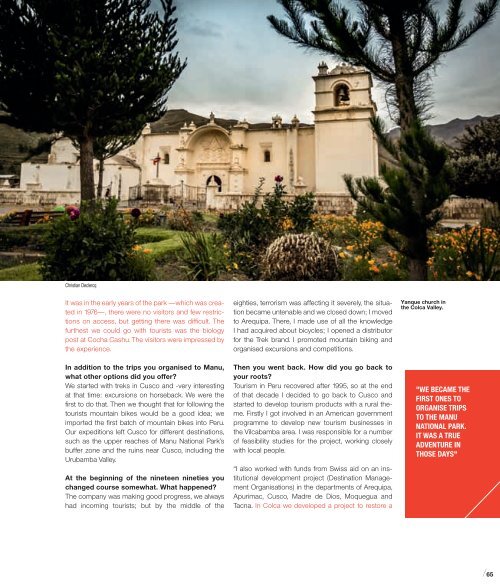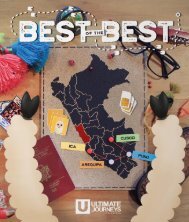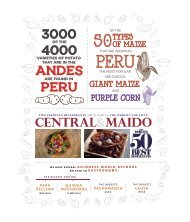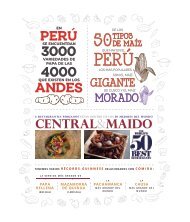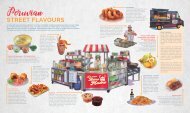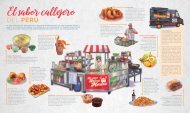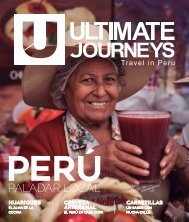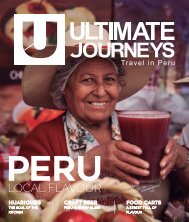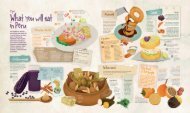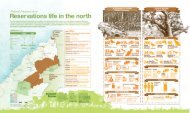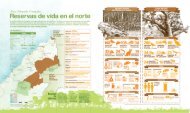UJ #9 - Adventure in Peru
You also want an ePaper? Increase the reach of your titles
YUMPU automatically turns print PDFs into web optimized ePapers that Google loves.
Christian Declercq<br />
It was <strong>in</strong> the early years of the park —which was created<br />
<strong>in</strong> 1976—, there were no visitors and few restrictions<br />
on access, but gett<strong>in</strong>g there was difficult. The<br />
furthest we could go with tourists was the biology<br />
post at Cocha Cashu. The visitors were impressed by<br />
the experience.<br />
In addition to the trips you organised to Manu,<br />
what other options did you offer?<br />
We started with treks <strong>in</strong> Cusco and -very <strong>in</strong>terest<strong>in</strong>g<br />
at that time: excursions on horseback. We were the<br />
first to do that. Then we thought that for follow<strong>in</strong>g the<br />
tourists mounta<strong>in</strong> bikes would be a good idea; we<br />
imported the first batch of mounta<strong>in</strong> bikes <strong>in</strong>to <strong>Peru</strong>.<br />
Our expeditions left Cusco for different dest<strong>in</strong>ations,<br />
such as the upper reaches of Manu National Park’s<br />
buffer zone and the ru<strong>in</strong>s near Cusco, <strong>in</strong>clud<strong>in</strong>g the<br />
Urubamba Valley.<br />
At the beg<strong>in</strong>n<strong>in</strong>g of the n<strong>in</strong>eteen n<strong>in</strong>eties you<br />
changed course somewhat. What happened?<br />
The company was mak<strong>in</strong>g good progress, we always<br />
had <strong>in</strong>com<strong>in</strong>g tourists; but by the middle of the<br />
eighties, terrorism was affect<strong>in</strong>g it severely, the situation<br />
became untenable and we closed down; I moved<br />
to Arequipa. There, I made use of all the knowledge<br />
I had acquired about bicycles; I opened a distributor<br />
for the Trek brand. I promoted mounta<strong>in</strong> bik<strong>in</strong>g and<br />
organised excursions and competitions.<br />
Then you went back. How did you go back to<br />
your roots?<br />
Tourism <strong>in</strong> <strong>Peru</strong> recovered after 1995, so at the end<br />
of that decade I decided to go back to Cusco and<br />
started to develop tourism products with a rural theme.<br />
Firstly I got <strong>in</strong>volved <strong>in</strong> an American government<br />
programme to develop new tourism bus<strong>in</strong>esses <strong>in</strong><br />
the Vilcabamba area. I was responsible for a number<br />
of feasibility studies for the project, work<strong>in</strong>g closely<br />
with local people.<br />
“I also worked with funds from Swiss aid on an <strong>in</strong>stitutional<br />
development project (Dest<strong>in</strong>ation Management<br />
Organisations) <strong>in</strong> the departments of Arequipa,<br />
Apurimac, Cusco, Madre de Dios, Moquegua and<br />
Tacna. In Colca we developed a project to restore a<br />
Yanque church <strong>in</strong><br />
the Colca Valley.<br />
"WE BECAME THE<br />
FIRST ONES TO<br />
ORGANISE TRIPS<br />
TO THE MANU<br />
NATIONAL PARK.<br />
IT WAS A TRUE<br />
ADVENTURE IN<br />
THOSE DAYS"<br />
/65


